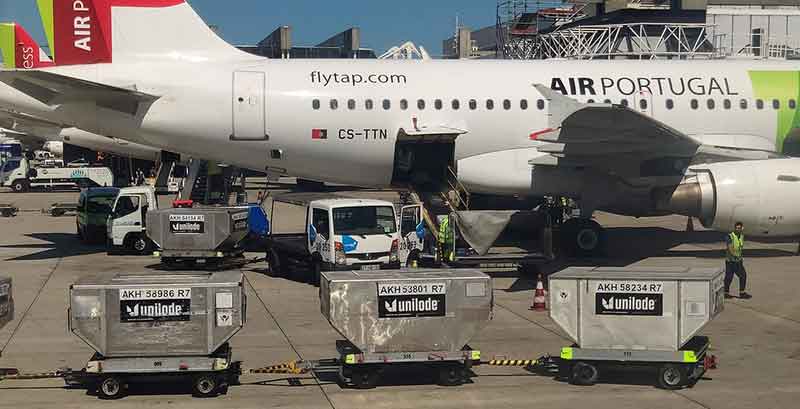Like sea freight, air cargo demands specialized storage containers and packing for transportation. With variations in size and shape among aircraft hold, air cargo containers come in diverse dimensions.
For your convenience, we will thoroughly explore the different air freight container types in this article, highlighting their features and significance in the aviation logistics landscape.
Types of air cargo containers
Air cargo containers, also known as Unit Load Devices (ULDs), pods, or cans, primarily exist in two types:
- Enclosed containers
- Pallets with net combinations
Currently, most air freight containers utilize sheet aluminum or polycarbonate materials with profile frames in their construction. Additionally, these containers adhere to standardized dimensions, allowing for ease of loading into an aircraft’s cargo hold.
Each ULD container and pallet possesses its unique International Air Transport Association (IATA) code for individual identification. Examples include AKE, AKN, PAG, and PMC, among numerous others.
While there are no restrictions on the type of cargo, air cargo containers are primarily employed for transporting the following categories of goods:
- Live animals like horse
- important document
- Medical supplements
- Radiopharmaceuticals
- Perishable goods like fresh catches, tropical fruits, or flowers
- Valuable products such as technology equipment and fashion items
Now that you know the basic air cargo container types, keep reading to get an overview of the most common variants and their container sizes.
Common ULD container specifications
1. LD1 container
IATA code:
AKC container
Dimensions:
Length: 92 inches (2.34m)
Width: 60.4 inches (1.53m)
Height: 64 inches (1.62m)
Maximum gross weight:
3501 lbs (1,588kg)
Volume capacity:
About 173 cubic feet (4.9 CBM)
Compatibility for:
Boeing 747, 777, or similar models
Features:
Suitable for smaller packages to odd-shaped items that can fit within its dimensions.
2. LD2 container
IATA code:
DPE contoured container
Dimensions:
Length: 61.5 inches (1.56m)
Width: 60.4 inches (1.53m)
Height: 64 inches (1.62m)
Maximum gross weight:
Approximately 2700 lbs (1,225kg)
Volume capacity:
Around 120 cubic feet (3.4 CBM)
Compatibility for:
B767, 787 lower hold
Features:
Lower deck containers that are half-width with an angled side. The door options include either canvas or solid materials.
3. LD3 container
IATA code:
AKE container
Dimensions:
Length: 79 inches (2m)
Width: 60.4 inches (1.53m)
Height: 64 inches (1.62m)
Maximum gross weight:
3,500 lbs (1,588kg)
Volume capacity:
155 cubic feet (4.39CBM)
Compatibility for:
B767, 747, 777, A300, A310, MD-11
Features:
AKE contoured container is open on one side and closes with a flap. It is suited for a wide-body lower deck.
4. LD6 container
IATA code:
ALF ULD container
Dimensions:
Length: 160 inches (4.1m)
Width: 60.4 inches (1.53m)
Height: 64 inches (1.62m)
Maximum gross weight:
7,000 lbs (3,175kg)
Volume capacity:
314 cubic feet (8.9CBM)
Compatibility for:
B767, 747, 777, A300, A310, MD-11
Features:
The ALF ULD, a full-width lower hold container, features angled ends. Its door is made of canvas and includes built-in door straps for added security and convenience.
4. LD6 container
IATA code:
ALF ULD container
Dimensions:
Length: 160 inches (4.1m)
Width: 60.4 inches (1.53m)
Height: 64 inches (1.62m)
Maximum gross weight:
7,000 lbs (3,175kg)
Volume capacity:
314 cubic feet (8.9CBM)
Compatibility for:
B767, 747, 777, A300, A310, MD-11
Features:
The ALF ULD, a full-width lower hold container, features angled ends. Its door is made of canvas and includes built-in door straps for added security and convenience.
5. LD8 container
IATA code:
DQF
Dimensions:
Length: 125 inches (3.17m)
Width: 60.4 inches (1.53m)
Height: 64 inches (1.62m)
Maximum gross weight:
5,401 lbs (2,450kg)
Volume capacity:
About 245 cubic feet (6.93CBM)
Compatibility for:
Boeing 767
Features:
For bulky or oversized cargo items.
6. LD11 container
IATA code:
ALP rectangular container
Dimensions:
Length: 125 inches (3.17m)
Width: 60.4 inches (1.53m)
Height: 64 inches (1.62m)
Maximum gross weight:
7,002 lbs (4,170kg)
Volume capacity:
262 cubic feet (7.4CBM)
Compatibility for:
A303, A310, DC-10
Features:
This ULD has a canvas door. The center post swings open for loading purposes.

Basic air freight pallet specifications
1. PLA half pallet
IATA code:
PLA half pallet with net
Dimensions:
Length: 125 inches (3.17m)
Width: 60.4 inches (1.53m)
Height: 64 inches (1.62m)
Maximum gross weight:
6,999 lbs (3,175kg)
Volume capacity:
250 cubic feet (7.1CBM)
Compatibility for:
747, 777, 787, 707F, 727F, 737F
2. PMC/P6P/96'' pallet
IATA code:
P6P 10-ft flat pallet with net
Dimensions:
Length: 125 inches (3.17m)
Width: 96 inches (2.43m)
Height: 64 inches (1.62m)
Maximum gross weight:
15,000 lbs (6,804kg)
Volume capacity:
747 cubic feet (21.2CBM)
Compatibility for:
B747, 767, 777, 787, DC-10, MD-11
Features:
Standard flat pallet suitable for lower cargo holds and main decks on aircraft.
3. LD7/88'' pallet
IATA code:
P1P flat pallet with net, PAG pallet
Dimensions:
Length: 125 inches (3.17m)
Width: 88 inches (2.24m)
Height: 64 inches (1.62m)
Maximum gross weight:
15,000 lbs (6,804kg)
Volume capacity:
747 cubic feet (21.2CBM)
Compatibility for:
707F, 727F, DC8F main decks and more
Features:
Standard flat pallet suitable for lower cargo holds and main decks on aircraft
Specialized air cargo container specifications
1. LD-3 temperature-controlled containers
IATA code:
RKN contoured cool container
Dimensions:
Length: 79 inches (2m)
Width: 60.4 inches (1.53m)
Height: 64 inches (1.62m)
Maximum gross weight:
3,500 lbs (1,558kg)
Volume capacity:
About 115 cubic feet (3.26CBM)
Compatibility for:
A330, B777, L1011
Temperature control range:
– 20C to +20C
2. Insulated LD-9 container
IATA code:
RAP cool container on P1P base
Dimensions:
Length: 125 inches (3.16m)
Width: 88 inches (22.4m)
Height: 64 inches (1.62m)
Maximum gross weight:
About 10,198 lbs (4,626kg)
Volume capacity:
339 cubic feet (9.6CBM)
Compatibility for:
747, 767, MD-11
Features:
An insulated ULD container with a sturdy solid door
Advantages and limitations of each air cargo container
The primary pros of air freight containers lie in ensuring flight safety. Containers and pallets are meticulously secured by the aircraft’s Cargo Loading System, preventing any movement during the flight.
ere are other notable advantages you can check:
- Safeguarding cargo against theft, decay, and damage.
- Allowing efficient handling and swift loading and unloading processes.
- Efficient use of space, ensuring optimal stacking and reducing wasted space.
However, every air cargo container type has a few limits concerning space utilization and suitability for different aircraft.
For instance, AKC and DPE air freight containers are not ideal for bulkier or oversized cargo and are better suited for narrow-body aircraft.
Conversely, ALF and ALP ULDs are suitable for transporting bulkier or irregularly shaped cargo due to their larger container size. But will occupy more space than standard containers, limiting the quantity of cargo that can be loaded.
Selecting an appropriate air cargo container is crucial as it not only optimizes space utilization, but also prevents unnecessary expenses.
At Airsupply, our air shipping experts specialize in customizing cost-effective and efficient logistics solutions. Furthermore, we offer assistance in constructing a ULD tailored to your specific shipment requirements, ensuring smooth shipping.




